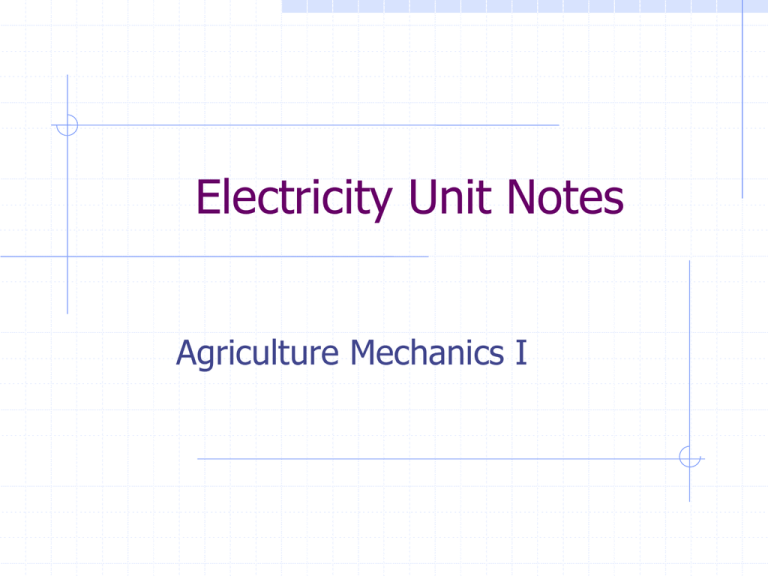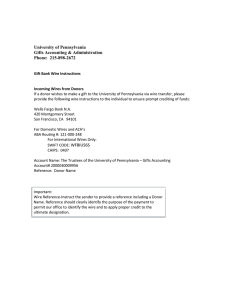Electrical PPT
advertisement

Electricity Unit Notes Agriculture Mechanics I Principles of Electricity Electricity is a form of energy that can produce light, heat, magnetism, chemical changes Resistance: tendency of a material to prevent electrical flow Conductor: if electricity flows easily Insulator: material that provides great resistance Amps, Volts, Watts Amperes: measure of the rate of flow of electricity in a conductor Volts: measure of electrical pressure Watts: measure of the amount of energy or work that can be done Ohms: measure of electrical resistance to flow Ohm’s Law Ohm = R Volts = E Amps = I Ohm’s Law: E = IR I=E/R R=E/I Electrical Safety Shock and Fire Never disconnect any safety device Don’t touch electrical items with wet hands or feet Don’t remove ground plug prong Use GFI in wet areas Discontinue use of extension cord that feels warm Don’t put extension cords under carpet Electrical Safety Install wiring according to NEC Blown fuse or breaker, determine cause Don’t replace fuse with larger fuse Don’t leave heat producing appliances unattended Heaters & lamps away from combustibles Don’t remove back of TV (30,000v when off) Electric motors lubricated, free of grease etc. Electrical Safety Keep appliances dry Don’t use damaged switches, outlets, fixtures, extension cords Follow manufacturer’s instructions for installation and use of electrical equipment Service Entrance Power from from power company Transformer: drops volts from 25,000 volts to 240 volts Service drop: wires etc from transformer to house Entrance head: weather-proof at house Meter: $$$ Service Entrance Panel (SEP): box with fuses or breakers Electric Meter Kilowatt-hours: how electricity is sold Kilo = 1000 Watt-hour = use of 1 watt for one hour n 100 watt light bulb for 1 hour - 100 watthours Kilowatt-hour = 1000 watts for one hour Electricity is priced and sold by the Kilowatt-hour. (kilo-1000) If you use 1000 watts of electricity for 1 hour, you use 1 kwh The price of a KwH of electricity is about 8 cents ($.08) How does it add up? If you run ten 100 watt light bulbs for one hour: 10 * 100 – 1000 watts 1000 watts = 1 kwh 1*.08 = $.08 (8 cents) How much does it cost? Assume that you have three 300 watt bulbs on the outside of your house. You turn the lights on at 9:00 p.m. and turn them off the next morning at 7. How much does it cost to run the bulbs through the night? How long did the bulbs run? From 9 until 7 is 10 hours How many total watts? 3*300 = 900 watts Watt-hours = 10 hrs * 900 watts = 9,000 watthours 9000/1000 = 9 kwh * $.08 = $.72 Try this one! A 5000 watt clothes dryer will dry a load of clothes in 1 hour. How much does it cost to dry the load of clothes? 5000 watts * 1 hr. = 5000 watt-hours 5000 watt-hours/1000 = 5 kilowatt-hours 5 kwh * .08 = $.40 (40 cents) If you can do this one, you’ve got it!! A football field has 36 bulbs rated at 500 watts. The coach turns on the lights at 5:00 p.m. and turns them off after the game at 10:00 p.m. How much does it costs to run the lights during the game? 36 bulbs x 500 = 18000 watts Time = 5 hours 18000*5=90000 watt-hours 90000/1000 = 90 kwh 900 * $.08 = $7.20 Branch Circuits usually begin at SEP branch out into a variety of places only 1 motor or; series of outlets or; series of lights use correct size wire and fuse or breaker Types of Cable Nonmetallic sheathed cable: copper or aluminum wire covered with paper, rubber, or vinyl for insulation Armored cable: flexible metal sheath with individual wires inside. Wires are insulated Conduit: tubing with individually insulated wires Wire Type and Size copper No 14 (14 gauge) = 15 amp circuits No 12 = 20 amps No 10 = 30 amps aluminum use one size larger lower gauge number = larger wire No 8 and larger use bundles of wires current travels on outer surface of wire, so a bundle of smaller wires can carry more Voltage Drop loss of voltage as it travels along a wire lights dim, motors overheat larger wires have less voltage drop for a given amount of current longer wire = greater problem must increase wire size as distance increases Wire Identification Type of outer covering, individual wire covering, cable construction, number of wires Wire type stamped on outer surface Wire Types Type T - dry locations Type TW - dry or wet THHN - dry, high temps THW and THWN - wet, high temps XHHW - high moisture & heat resistance UF - direct burial in soil but not concrete Wire Identification Color coded: black, red, & blue = positive or hot wires which carry current to appliances White = neutral wires carry current from appliance back to source Green or Bare = ground all metal boxes and appliances Wire Identification Wire Size: 12-2 has two strands of No. 12 wire (black & white) 12-2 w/g same, with one green or bare 12-3 has three strands of No. 12 (black, red, white) 12-3 w/g same, with green or bare What are Wiring Boxes? hold cable or conduit and protect connections attached to building contain all electrical connections not in fixtures rectangular or octagonal various depths some have removable sides for expansion must be fastened securely to building What are Wiring Boxes? cable clamped to box secure cable grounded if metal wires must be soldered or use wire nuts no more than one wire to each screw of receptacle positive wires attach to yellow screws, neutral wires to white screws, ground wires to green screws What are Wiring Boxes? when a white wire is used as positive, paint black or use black tape four wires per standard box (not counting ground wires) duplex receptacle may be on two circuits by breaking metal tab What is a Single-Pole Switch? it is the only switch on the circuit it opens/closes the positive wire Light Wiring Concepts always begin at the SEP Black or Hot wire comes out of SEP, goes to the switch Black wire leave switch, goes to light White wire leaves light, returns to SEP SEP Wire Nut SEP SEP SEP Three-Way Switch used in pairs control from two different locations 3 terminals (screws) current (black wire) feeds into Common Terminal (dark screw) current flows out of other two screws through Traveler Wires to other 3way switch Three-Way Switch current flows out of other switch from the Common Terminal current flows to light or receptacle SEP W SEP B W SEP W R SEP SEP B W B SEP B W B R
